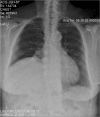Unilateral hemidiaphragm weakness is associated with positional hypoxemia in REM sleep
- PMID: 22334810
- PMCID: PMC3266330
- DOI: 10.5664/jcsm.1662
Unilateral hemidiaphragm weakness is associated with positional hypoxemia in REM sleep
Abstract
Background: Patients with unilateral diaphragmatic paralysis (UDP) have been reported to have varied respiratory symptoms and often reduced lung function. We sought to describe the polysomnographic respiratory characteristics in patients with UDP without obstructive sleep apnea.
Methods: We prospectively collected 5 cases with clinical investigation regarding symptoms, lung function, and nocturnal polysomnography. The respiratory sleep characteristics were analyzed with standardized scoring of respiratory events in 30-sec epochs and comparison according to sleep-wake stages and body position with respect to oximetry. The cases were compared to 5 controls matched for age, gender, and body mass index.
Results: Three of 5 patients had significant awake lung restriction with a mean (range) forced vital capacity of 1.89 (1.48-2.24) liters, 72% (45% to 102%) predicted. All had REM sleep with few apneas and episodes of prolonged hypopneas characterized by important desaturation noted on oximetry. These desaturations were greatest during REM sleep when the patients slept supine with a mean (SD) saturation of 90.8% (4.5%) and minimum of 64% or on the side unaffected by UDP with a mean saturation of 87.8% (5.3%) and minimum of 67% (p < 0.0001 compared to same positions awake). Other sleep stages had few, if any significant desaturations and these events rarely occurred when the patient slept in the supine position. Saturation was lower in all sleep-wake stages and sleep positions compared to controls (p < 0.0001).
Conclusion: Patients with UDP demonstrate position-dependent hypopneas in REM sleep with frequent desaturations.
Keywords: Unilateral diaphragmatic paralysis; diaphragmatic disorders; hypoxemia; polysomnography; sleep; sleep disordered breathing.
Figures
Similar articles
-
[The impact of unilateral diaphragmatic paralysis on sleep-disordered breathing: a scoping review].Can J Anaesth. 2021 Jul;68(7):1064-1076. doi: 10.1007/s12630-021-01970-y. Epub 2021 Mar 16. Can J Anaesth. 2021. PMID: 33725316 French.
-
Nocturnal hypoxia in unilateral diaphragmatic paralysis.Respiration. 1991;58(2):95-9. doi: 10.1159/000195905. Respiration. 1991. PMID: 1862258
-
Positional vs nonpositional obstructive sleep apnea patients: anthropomorphic, nocturnal polysomnographic, and multiple sleep latency test data.Chest. 1997 Sep;112(3):629-39. doi: 10.1378/chest.112.3.629. Chest. 1997. PMID: 9315794
-
Sleep-disordered breathing in unilateral diaphragm paralysis or severe weakness.Eur Respir J. 2008 Dec;32(6):1479-87. doi: 10.1183/09031936.00018808. Epub 2008 Aug 6. Eur Respir J. 2008. PMID: 18684853
-
Sleep-wake cycles and the management of respiratory failure.Curr Opin Pulm Med. 1996 Nov;2(6):500-6. Curr Opin Pulm Med. 1996. PMID: 9363192 Review.
Cited by
-
[The impact of unilateral diaphragmatic paralysis on sleep-disordered breathing: a scoping review].Can J Anaesth. 2021 Jul;68(7):1064-1076. doi: 10.1007/s12630-021-01970-y. Epub 2021 Mar 16. Can J Anaesth. 2021. PMID: 33725316 French.
-
Shrinking lung syndrome: vanishing in non-rapid eye movement sleep.J Clin Sleep Med. 2023 Nov 1;19(11):1975-1979. doi: 10.5664/jcsm.10730. J Clin Sleep Med. 2023. PMID: 37477153 Free PMC article. Review.
-
Practical approach to respiratory emergencies in neurological diseases.Neurol Sci. 2020 Mar;41(3):497-508. doi: 10.1007/s10072-019-04163-0. Epub 2019 Dec 2. Neurol Sci. 2020. PMID: 31792719 Free PMC article. Review.
-
Sleep disordered breathing in isolated unilateral and bilateral diaphragmatic dysfunction.J Clin Sleep Med. 2014 May 15;10(5):509-15. doi: 10.5664/jcsm.3698. J Clin Sleep Med. 2014. PMID: 24910552 Free PMC article.
-
Is polysomnographic examination necessary for subjects with diaphragm pathologies?Clinics (Sao Paulo). 2016 Sep;71(9):506-10. doi: 10.6061/clinics/2016(09)04. Clinics (Sao Paulo). 2016. PMID: 27652831 Free PMC article.
References
-
- Douglass BE, Clagett OT. The prognosis in idiopathic diaphragmatic paralysis. Chest. 1960;37:294–7. - PubMed
-
- Riley EA. Idiopathic diaphragmatic paralysis. A report of eight cases. Am J Med. 1962;32:404–16. - PubMed
-
- Laroche CM, Carroll N, Moxham J, Green M. Clinical significance of severe isolated diaphragm weakness. Am Rev Respir Dis. 1988;138:862–6. - PubMed
-
- Hughes PD, Polkey MI, Moxham J, Green M. Long-term recovery of diaphragm strength in neuralgic amyotrophy. Eur Respir J. 1999;13:379–84. - PubMed
Publication types
MeSH terms
LinkOut - more resources
Full Text Sources




